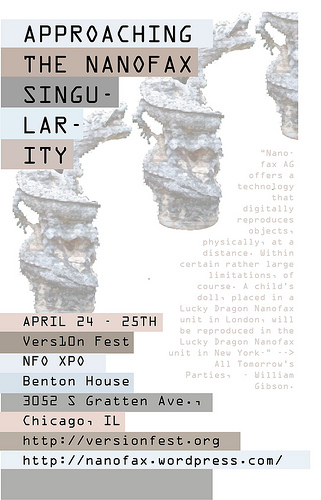Some cool speedy prototyping costs pictures:
Approaching the Nanofax Singularity

Image by burtonwood + holmes
Approaching the Nanofax Singularity
“Nanofax?”
“Everything the name implies,” says Klaus, “and significantly much less.”
“What’s that supposed to imply?”
“Nanofax AG gives a technology that digitally reproduces objects, physically, at a distance. Inside specific rather massive limitations, of course. A child’s doll, placed in a Lucky Dragon Nanofax unit in London, will be reproduced in the Fortunate Dragon Nanofax unit in New York-”
From All Tomorrow’s Parties, by William Gibson.
Published by Putnam in 1999
The theme for the tenth edition of Version Fest is Territories and Infrastructure. Infrastructure is represented in our lives by fiber optic cables delivering the data that keeps us trucking. It is the faucet delivering water to our home, the asphalt we drive on, the flight strategy our pilot takes. Infrastructure is the bridges, the networks, the grocery shops. It is the logistical machine the keeps modern life rolling on. But infrastructure is not just the pipes, and the tubes, and the faucets that deliver culture, but the material and techniques that manufacture those pipes, tubes, cables and what not. Infrastructure is the tools we use to develop.
Recently a new raft of technologies have entered the digital domain, these tools for replicating and manufacturing have currently rapidly changed the way we believe about making items. For artists these days these tactics and techniques represent a new infrastructure.
Approaching the Nanofax Singuarity is a two day symposium featuring presentations and exhibits by artists and designers utilizing the latest strategies in digital fabrication and replication. Hardware as soon as the sole domain of engineers and scientists have grow to be significantly a lot more accessible in the final five years. Sophisticated by open source technology, devoted hacktivists, tinkerers and homebrew engineers have brought this infrastructure from the lofty heights of the machine shop into the alt space network. Now it is achievable for designers with a little price range and workspace to make use of tools and gear such as three-d printers, RepRap, CNC machines, 3-d scanners, laser cutters and so forth.
So whether or not it is producing the tools to make the art, or creating the art with the tools we’ve produced, or generating the art with open source tools, there exist several possibilities and choices for designers and artists to interact with new digital fabrication methods. Approaching the Nanofax Singuarity (ATNS) seeks to show case some of these artists presently operating in this field here in Chicago.
Margarita Benitez performs with fiber, sound and technological components in her practice, she will talk about her new project osloom an open supply jacquard loom she is currently developing. DIYLILCNC is a collaborative project by artists Chris Reilly and Taylor Hokanson. Their project is a low price open supply DIY three axis CNC mill. Chris and Taylor will demonstrate the machine and speak about CNC technology in general, some of the shortcomings of the present state of CNC and how those are addressed by open-source hardware projects like the DIYLILCNC. We’ll also go more than the specs of the DIYLILCNC, giving details about how it is constructed and its functions. (f)utility projects are a collaboration between Paola Cabal, Michael Genge and Christopher Grieshaber. Prior projects incorporate Depth of Field presently on view at SubCity Projects in Chicago. (f)utility projects will be making the ATNS pavilion at the NFO XPO. The pavilion will host exhibited projects by ATNS artists. Claudia Hart produces designs for sublime landscape gardens usually containing expressive and sensual female bodies meant to interject emotional subjectivity into what is usually the overly-determined Cartesian planet of digital design. Mik Kastner and Brian Matthew are members of the Bio Art Network they will speak about their “bio printer” a rapid prototyping machine that will create organic sculptures from plant and animal cells. Patrick Lichty is a technologically-based conceptual artist, writer, independent curator, animator for the activist group, The Yes Men, and Executive Editor of Intelligent Agent Magazine. Lichty will exhibit his Pixelbox series, laser cut LED pieces whose simple look belays an experiment in emergent behavior. Dan Value combines sculpture, overall performance and experimental documentary practice. His present project Tentacle Shelter will be a wearable “shelter” for a youngster – like a costume/cape/tent developed in thick felt. For ATNS Value will exhibit a laser cut model and prototype for the shelter. Ben Stagl investigates urban space through a selection of mediums like sculpture, performance, video, and installation. Stagl is largely concerned with how human beings continue to address and knowledge shared spaces. Several of his projects discover concepts of inclusion by way of object, frequently involving collaboration and elements of participation.
Taken collectively these artists articulate each sides of the coin in terms of digital fabrication. Regardless of whether their project is to make the tools of production and distribute them freely to other individuals. Or take up these tools and generate new performs by way of the CNC machine, bio printer, rapid prototyper or the laser cutter their function is at the top edge of modern day manufacturing techniques.
The universe is hacking, it’s software, it’s mobile internet, it is speedy prototyping, it’s hardware hacks, the notion of digital infrastructure for artists and designers just goes on and on. The current post in Wired by Chris Anderson points to this momentum and suggests that what Kinkos was to the 80’s and 90’s so speedy prototyping and it’s numerous cousins will be to the tens or what ever this decade is going to be referred to as.
Tom Burtonwood, April 2010
References:
en.wikipedia.org/wiki/All_Tomorrow’s_Parties_(novel)